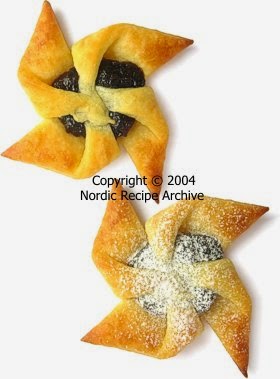Everyone knows that Santa Claus lives in the north of Finland, so it would be remiss not to include a Finnish Christmas treat during the Christmas Countdown. I discovered these rich and delicious pin wheel shaped, jam filled pastries fairly late in life - I think it was Christmas 2000, a few months before I first went to Finland. They not only taste good, they look beautiful - the golden pastry star pinwheels with a rich, dark coloured prune jam filling.
Here is some information from "arousing appetites " blog.
What is Joulutortut?While the name for the Finnish joulutortut now translates into English as “Christmas tart”, many of the traditions the Finnish have pre-date Christianity’s influence and come from a rather older Viking heritage. In the pre-Christian times, the Vikings in Nordic countries observed hjul, or “sun wheel,” a celebration of the winter solstice that brought back the sunlight to the darkened region. During hjul, the Vikings would have a three-day festival for eating and drinking, playing games, and exchanging gifts. Needless to say their tradition weren’t too far off from Christmas as we celebrate today.
When Christianity did come to the region in around the 12th century, rather than replace the old Viking ways, the two traditions began to assimilate. For example, the adopted Finnish word for Christmas, joulu, is an evolution from the Viking hjul.
In Finnish homes nowadays, joulutortut and other Christmas specialties are made and served for the first time at a celebration called pikkujoulu. The pikkujoulu, or “little Christmas,” are gatherings and parties held for friends, family, and even the local community. And while the timing of the pikkujoulu lines up conveniently with the first advent of the Christian calendar, these parties are much more free-form and are hardly religious. Really, they’re just a great reason to get together to eat, drink, be merry, and yes… enjoy some joulutortut.
My Finnish friends tell me that quark is an essential ingredient, a soft white cheese made by warming sour milk until coagulated and strained - ricotta cheese is a substitute. ... and of course the prune jam must be homemade! However, the recipe below uses cream, and works well.
{ Joulutortut :: Finnish Christmas Stars } Recipe by Beatrice Ojakangas from The Great Scandinavian Baking Book
* Ingredients *
2 cups pitted prunes
Water to cover
2 tablespoons lemon juice
1/2 cup sugar
3 cups plain flour
1 teaspoon baking powder
1 1/2 cups heavy cream, whipped
1 cup softened butter
Beaten egg, for glaze
2 cups pitted prunes
Water to cover
2 tablespoons lemon juice
1/2 cup sugar
3 cups plain flour
1 teaspoon baking powder
1 1/2 cups heavy cream, whipped
1 cup softened butter
Beaten egg, for glaze
* Directions *
Cover the prunes with water and simmer slowly until very soft. Puree and add the lemon juice and sugar. Cool.
Cover the prunes with water and simmer slowly until very soft. Puree and add the lemon juice and sugar. Cool.
For the pastry, mix the flour and baking powder. Stir into the whipped cream and knead in the softened butter. Shape dough into a ball and chill overnight.
On a floured board, roll out pastry to 1/4 inch or 6mm thickness. Fold dough into third, folding first one third over the centre, then the opposite third over the centre. Roll out to seal the layers. Turn dough and fold again into thirds, making the dough into a perfect square. Roll out, retaining the square shape, to make an 18 inch or 45 cm square. Cut into 3 inch or 7.5 cm squares. With a sharp knife, make cuts from the corners towards the centre of the squares about half way along. Place a spoonful of the prune filling onto the centre of each square. Shape into pinwheel stars by lifting every other split corner towards the centre onto the filling. Cover baking sheets with parchment paper and preheat the oven to 400F / 200C. Place filled stars onto the baking sheets, and brush with the glaze. Bake for 7-10 minutes or until lightly browned.
Makes 36
Here is another recipe with step by step photos, because the hard bit is shaping the pastries!
Hyvaa Joulua ( Merry Christmas)




Comments
Post a Comment
Thanks for reading my blog and please share your thoughts about my blog post by leaving a comment.Your comment won't appear immediately as comments are verified before publication in an effort to reduce the amount of spam appearing. Anonymous comments will not be published.